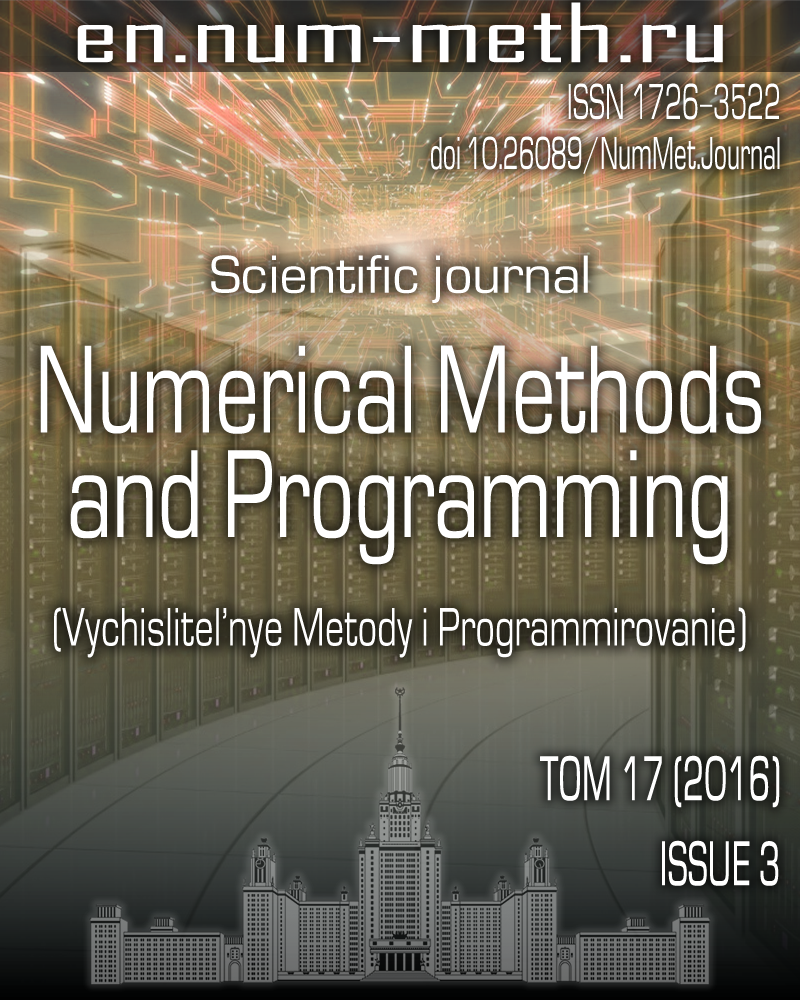DOI: https://doi.org/10.26089/NumMet.v17r324
Mathematical modeling of inverse multipoint forming problems in the creep mode using a reconfigurable tool
Keywords:
inverse forming problems
contact conditions
variational equations
convergence
finite element method
iterative method
multipoint forming
Abstract
A mathematical formulation of inverse forming problems in the creep mode using a reconfigurable tool is based on the creation of functionals for the direct and inverse extreme quasistatic problems of forming details with consideration of contact conditions with equipment. An iterative method of determining the displacements of pins of the tool’s matrices providing a given residual curvature of the panel is proposed. The problems are numerically solved by a finite element method in the framework of the MSC.Marc system. The convergence of the proposed iterative method is shown by an example of panel shaping.
Published
2016-06-27
Issue
Section
Section 1. Numerical methods and applications
References
- O. V. Sosnin, B. V. Gorev, and I. V. Lyubashevskaya, “High-Temperature Creep and Superplasticity of Materials,” Zh. Prikl. Mekh. Tekh. Fiz. 38 (2), 140-145 (1997) [J. Appl. Mech. Tech. Phys. 38 (2), 293-297 (1997)].
- B. V. Gorev, V. A. Panamarev, and V. N. Peretyat’ko, “Energy-Based Theory of Creep in the Pressure Treatment of Metals,” Izv. Vyssh. Uchebn. Zaved., Chern. Metall., No. 6, 16-18 (2011) [Steel Transl. 41 (6), 461-463 (2011)].
- V. A. Panamarev, V. N. Peretyat’ko, and B. V. Gorev, “Kinetic Equations of Creep in Hot Metal under Continuous and Incremental Loading,” Izv. Vyssh. Uchebn. Zaved., Chern. Metall., No. 12, 53-54 (2011).
- O. V. Sosnin, A. F. Nikitenko, and B. V. Gorev, “Justification of the Energy Variant of the Theory of Creep and Long-Term Strength of Metals,” Zh. Prikl. Mekh. Tekh. Fiz. 51 (4), 188-197 (2010) [J. Appl. Mech. Tech. Phys. 51 (4), 608-614 (2010)].
- I. A. Banshchikova, B. V. Gorev, and I. Yu. Tsvelodub, “Creep of Plates Made of Aluminum Alloys under Bending,” Zh. Prikl. Mekh. Tekh. Fiz. 48 (5), 156-159 (2007) [J. Appl. Mech. Tech. Phys. 48 (5), 751-754 (2007)].
- B. V. Gorev, “Bulky Parts Forming Technology from Sheet and Plates under Creep Conditions,” Tekhnol. Mashinostroeniya, No. 2, 11-17 (2008).
- B. D. Annin, A. I. Oleinikov, and K. S. Bormotin, “Modeling of Forming of Wing Panels of the SSJ-100 Aircraft,” Zh. Prikl. Mekh. Tekh. Fiz. 51 (4), 155-165 (2010) [J. Appl. Mech. Tech. Phys. 51 (4), 579-589 (2010)].
- F. C. Ribeiro, E. P. Marinho, D. J. Inforzato, et al., “Creep Age Forming: A Short Review of Fundaments and Applications,” J. Achiev. Mater. Manufact. Eng. 43 (1), 353-361 (2010).
- I. A. Banshchikova, B. V. Gorev, and I. V. Sukhorukov, “Two-Dimensional Problems of Beam Forming under Conditions of Creep,” Zh. Prikl. Mekh. Tekh. Fiz. 43 (3), 129-139 (2002) [J. Appl. Mech. Tech. Phys. 43 (3), 448-456 (2002)].
- I. Yu. Tsvelodub, A Stability Postulate and Its Applications in the Theory of Creep for Metallic Materials (Hydrodynamics Inst., Novosibirsk, 1991) [in Russian].
- K. S. Bormotin, “An Iterative Method for the Solution of Inverse Shaping Problems under Creep Conditions,” Vychisl. Metody Programm. 14, 141-148 (2013).
- K. S. Bormotin, “Iterative Method for Solving Geometrically Nonlinear Inverse Problems of Structural Element Shaping under Creep Conditions,” Zh. Vychisl. Mat. Mat. Fiz. 53 (12), 2091-2099 (2013) [Comput. Math. Math. Phys. 53 (12), 1908-1915 (2013)].
- I. D. Klopotov, I. V. Lyubashevskaya, G. A. Raevskaya, L. L. Rublevskii, and O. V. Sosnin, RF Patent No. 2 251 464, Byull. Izobret., No. 13 (2005).
- L. L. Rublevskii, O. V. Sosnin, B. V. Gorev, and M. I. Bondarenko, RF Patent No. 2 076 010, Byull. Izobret., No. 9 (1997).
- W. W. Wang, B. B. Jia, and J. B. Yu, “A New Flexible Sheet Metal Forming Method and Its Stamping Process,” in Proc. 14th IFToMM World Congress, Taipei, Taiwan, October 25-30, 2015 ,
doi 10.6567/IFToMM.14TH.WC.PS20.006 - D. Simon, L. Kern, J. Wagner, and G. Reinhart, “A Reconfigurable Tooling System for Producing Plastic Shields,” Procedia CIRP 17, 853-858 (2014).
- H. Lin, W. Min, C. Cailou, and J. Xiusheng, “FEM Analysis of Spring-backs in Age Forming of Aluminum Alloy Plates,” Chin. J. Aeronaut. 20 (6), 564-569 (2007).
- V. Păunoiu, E. Găvan, and A. Dimache, “Springback Analysis in Reconfigurable Multipoint Forming of Thick Plates,” The Annals of Dunarea de Jos University of Galati, Technologies in Machine Building, Fascicle V, ISSN 1221-4566, 47-54 (2012).
- K. S. Bormotin, “Numerical Modeling of a Problem Forming with Contact Conditions in a Plasticity and Creep Mode,” Naukovedenie, No. 1, 1-13 (2014).
- P. Wriggers, Computational Contact Mechanics (Springer, Heidelberg, 2006).
- S. N. Korobeinikov, Nonlinear Deformation of Solids (Izd. Ross. Akad. Nauk, Novosibirsk, 2000) [in Russian].
- R. Hill, “On Uniqueness and Stability in the Theory of Finite Elastic Strain,” J. Mech. Phys. Solids 5 (4), 229-241 (1957).
- F. P. Vasil’ev, Methods of Optimization (Faktorial Press, Moscow, 2002) [in Russian].
- K.-J. Bathe, Finite Element Procedures (Prentice Hall, Upper Saddle River, 1982).
- N.-H. Kim, Introduction to Nonlinear Finite Element Analysis (Springer, New York, 2015).
- Marc: Advanced Nonlinear Simulation Solution, MSC.Software Corporation.
http://www.mscsoftware.com/product/marc . Cited July 14, 2016.


